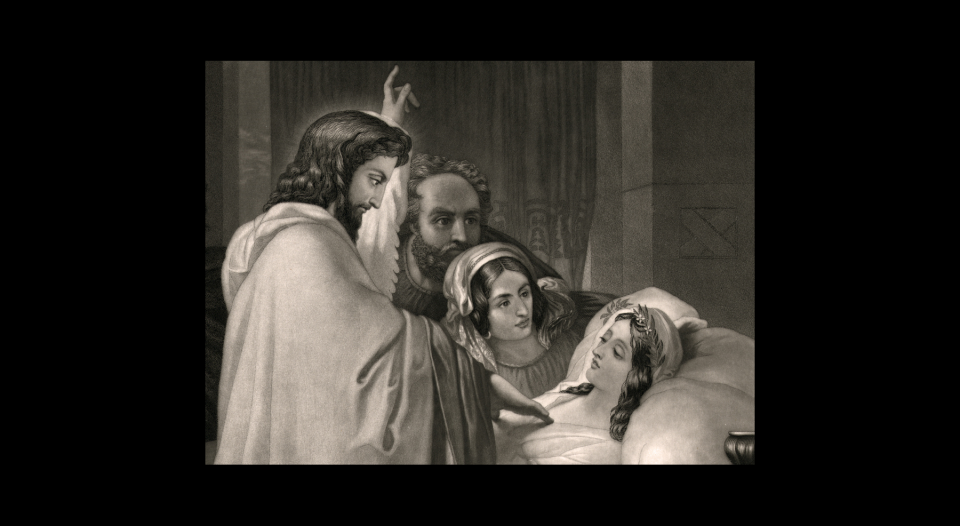Lectionary for June 30, 2024
Sixth Sunday after Pentecost
2 Samuel 1:1, 17-27; Psalm 130;
2 Corinthians 8:7-15; Mark 5:21-43
This week in the lectionary I was turned on to a bit of detail that I’ve missed for as long as I’ve been reading Mark 5: Jairus and the woman with the blood issue are intimately connected. While studying for this reflection, I read a piece by scholar Betsy Barber called “A Tale of Two Daughters.” She draws the connection that in the latter part of Mark 5 there is no interruption, just a combined story of two daughters receiving healing.
In the first story, Jesus had reversed the perilous night sailing that had almost ended in disaster about 12 hours earlier. Along with the disciples, he arrived back in friendly Galilean-Israelite territory, where he was mobbed by a group eager to hear his teachings and see his miracles. While there the synagogue president came to ask Jesus to heal his little daughter. Jesus obliged, left his teaching at the seashore and headed to the man’s house to heal his daughter. On the way, men came from Jairus’ house to tell him not to bother because his daughter had died. Still, Jesus pressed on with Jairus, Peter, Jacob/James, John and the girl’s mother into the room where the dead girl lie (Mark 5:40). Jesus told the girl to get up, and she did. He restored the daughter to her parents.
But, while on the way to Jairus’ house, while still in the midst of a claustrophobia-inducing crowd, a woman with an issue of blood came and touched Jesus’ outer garment and was instantly healed. Jesus told her, “Daughter, your faith has made you well. Go in peace and be cured of your disease.” She is the second of two daughters Jesus turned his attention to that day.
Now, Mark is a speedy Gospel, with lots of “immediately” and relatively few details. Both Matthew and Luke specify that the woman touched the ritual fringes of Jesus’ garment (Numbers 15:37-41; Deuteronomy 22:12), while Mark just says she touched his garment. When Mark pauses from the laconic style to include an extra detail, it has a purpose.
The woman Jesus calls daughter has been bleeding for 12 years (Mark 5:25). The girl whom Jairus calls daughter has been alive for 12 years (42). When Jesus was still speaking to the woman, people came from the house of the synagogue official to say, “Your daughter is dead. Why trouble the teacher any further?” (35). There is no indication of a side conversation or that these words were spoken to Jairus. I think these messengers spoke to the woman with whom Jesus was speaking.
Jesus told her, “Daughter, your faith has made you well. Go in peace and be cured of your disease.” She is the second of two daughters Jesus turned his attention to that day.
Also, suddenly, after the healing of the bleeding woman, Jairus’ wife—the girl’s mother—is present and with Jesus and his three disciples outside of the girl’s room (40). She wasn’t in the home but had come there with Jesus and Jairus. I interpret this to mean that Jairus’ daughter is also the child of the woman healed from the issue of blood. Jesus healed two daughters in the same family that day.
What does this mean? The woman had had an issue of blood from a difficult birth 12 years earlier. She tended to her daughter every day that she could. Besides, integrating into public life fully while being perpetually unclean was a risk. Pharisees and people of similar views would be offended by her presence or touch, while others would not have been concerned. But she never knew who would take offense. Once her daughter died—surely she knew before the men who came to tell her husband—she slipped away. But upon hearing that the healer was close to their home, she sought to stop the bleeding. If she couldn’t heal her broken heart from her daughter’s death, at least she could finally find healing for her injured body. Jesus healed her body and then healed her heart by raising her daughter.
When the woman who had been healed told Jesus “the whole truth” (33), I don’t think she was just saying that she touched him. Jesus was looking for her, specifically, and already knew who she was and that she had been healed (32). Instead, she told Jesus about her daughter. At that moment, Jesus selected fewer disciples, didn’t allow anyone in the mob to follow him, and made haste to Jairus’ house to heal the girl.
Jesus can be trusted with “the whole truth” and all the ways that we need to be healed. We don’t have to be modest with our requests, because the one who heals is the one who raises. The one who comforts is the one who accompanies. And the one who removes fear is the one who shows that there is nothing to fear, not even death.





